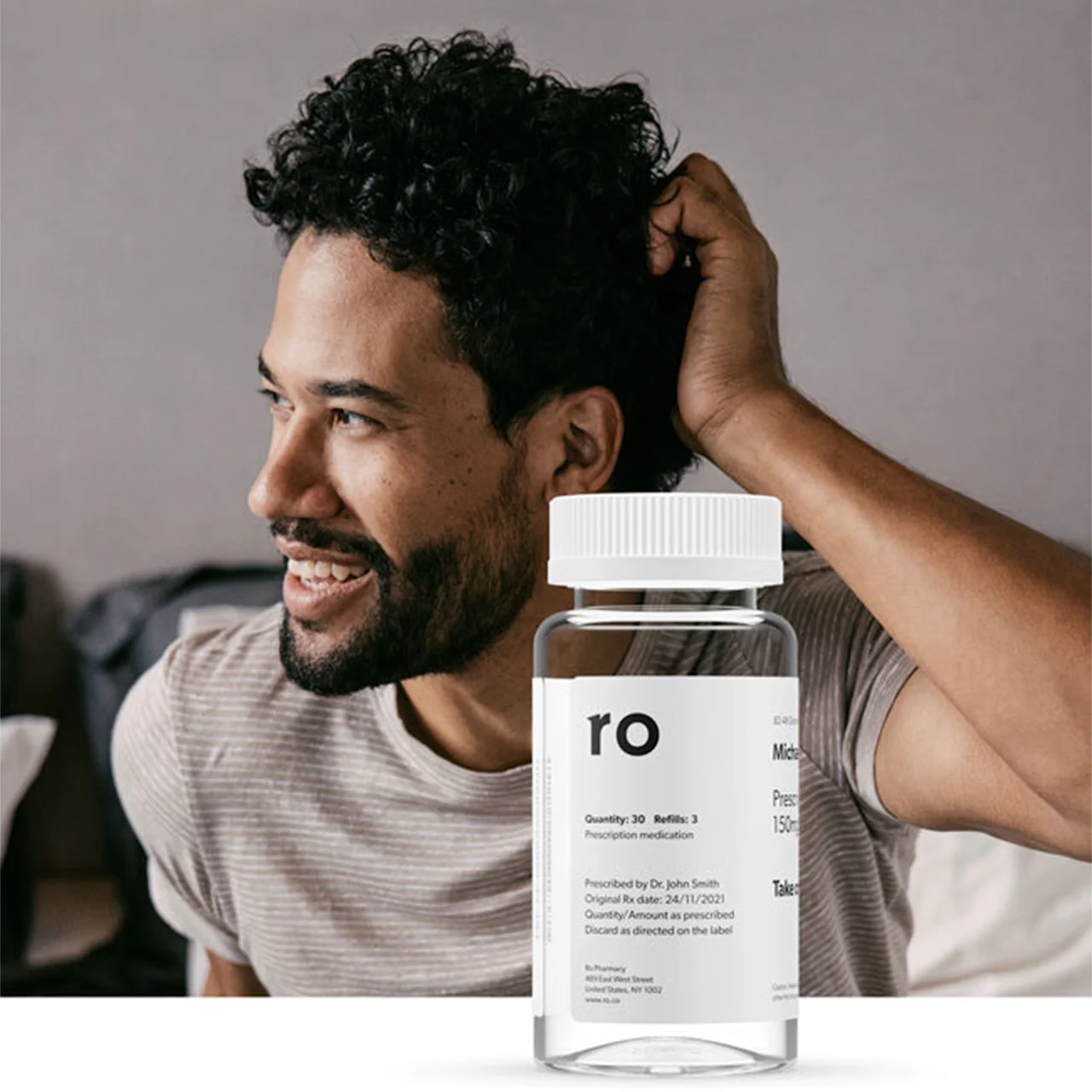Topical finasteride vs. oral finasteride: what is the difference?

Reviewed by Felix Gussone, MD, Ro,
Written by Anna Brooks
last updated: Sep 07, 2023
5 min read
Here's what we'll cover
Here's what we'll cover
By age 50, half of men experience the most common type of hair loss, androgenic alopecia. Knowing this, it is not surprising that the quest for a cure for baldness began a long time ago and continues to this day. In ancient Greece, Hippocrates developed a medical recipe for baldness in men that was purportedly a mixture of horseradish and bird droppings, among other ingredients.
While that formula may not have worked, the evolution of hair loss science has led to other medications successfully slowing or reversing hair loss in men.
One example is finasteride (see Important Safety information), a medication that can stop male pattern baldness in over 80% of men who took the drug for two years.
Nowadays, finasteride is available in an oral or topical (applied directly to the scalp) formula, although only the oral medication is FDA-approved for hair loss. If you’re experiencing hair loss and exploring treatment options like finasteride, you might wonder which is more effective or has the better side effect profile: topical or oral finasteride?
What is finasteride?
Finasteride, also known under the brand names Propecia and Proscar, is a prescription medication. It is a 5-alpha-reductase inhibitor and can treat multiple conditions – including androgenic alopecia and benign prostatic hyperplasia (enlarged prostate) – by regulating certain hormones.
Testosterone naturally converts into a hormone called dihydrotestosterone (DHT). Studies show that men with male pattern hair loss have higher levels of DHT in the scalp, which can cause hair follicles to shrink. Over time, the shrinking follicles produce thinner hairs, and, eventually, lead to hair loss. Finasteride limits the conversion of testosterone into DHT and thus slows hair loss and promotes hair regrowth.
Because finasteride is so effective at suppressing DHT production, it has become the gold standard for hair loss treatment—and is often used together with minoxidil (brand name Rogaine), an over-the-counter hair loss treatment you can apply directly to the scalp.
Oral finasteride, approved for androgenic alopecia in men since 1997, is not meant for women of childbearing age because of its potential to cause birth defects in unborn children.
Topical finasteride vs. oral finasteride
Unlike oral finasteride, topical finasteride is not FDA-approved to treat male pattern hair loss. You might wonder: why bother trying a topical product if it’s not FDA-approved? Doesn’t that make oral finasteride your best bet? Not necessarily.
Topical finasteride can still be prescribed off-label by physicians, and many men find it safe and effective. If you’re torn between the two, here’s a breakdown of each product.
Oral finasteride
Available via prescription from a healthcare provider, oral finasteride comes in easy-to-take tablets. This makes it an appealing, mess-free option for people who might not want to deal with topical products that can leave hair looking or feeling greasy. Oral finasteride is also a long-term product, meaning you need to take it daily for at least six to 12 months before potentially seeing results.
Side effects
While less than 2% of men experience adverse reactions to oral finasteride, the risk of the main reported side effects–decreased libido and erectile dysfunction (ED)– can make people apprehensive about starting it, or if they’re already on the medication, stop taking it altogether. Because it’s an oral medication that requires multiple systems in the body to process it, there’s a chance it could impact areas unrelated to the scalp or head.
The most commonly reported side effects include:
Decreased sex drive
Testicular pain
Difficulty achieving orgasm
Mood swings
Sleep disturbances
Suicidal ideation
Less common reactions include breast enlargement (gynecomastia), skin rashes, and allergic reactions, but these are typically only seen at a higher dose.
Cost
If you’re taking oral finasteride for hair loss, insurance isn’t likely to cover it. Brand-name products are more expensive, so if you’re going with Propecia, you’re looking at roughly $100-150 for a 30-day supply. Generic finasteride is cheaper and can cost $25 or less for a month’s supply
Topical finasteride
Similar to minoxidil products, topical finasteride comes in a liquid solution applied directly to the scalp using a spray, gel, or dropper and massaged in. Topical finasteride works in the same way as oral finasteride – by blocking the conversion of testosterone to DHT. It has also been shown to yield similar results as the oral product: preventing hair loss and encouraging hair regrowth.
In the U.S., topical finasteride requires a prescription, just like oral finasteride.
Side effects
Because topical finasteride does not enter the bloodstream in the same way or quantity oral finasteride does, there’s reason to assume that topical finasteride could come with a lower risk of systemic effects, including sexual side effects. But more research is needed to say that with certainty. Some men using topical finasteride may still experience similar side effects as oral finasteride.
So far, studies and anecdotal reports report the following potential side effects:
Burning or itchy scalp
Irritation on and around the application side
Skin redness
Skin rash
These effects are typically mild when they occur and go away if you stop using the product. Though serious allergic reactions are rare if you experience severe itching, rash, or swelling around the face and neck, stop using the product and seek medical attention immediately.
Cost
Topical finasteride isn’t necessarily more expensive than oral finasteride. However, options for where you can get topical finasteride are limited. Topical finasteride can be prescribed through a physician, dermatologist, and certain telehealth providers. Costs range, but you can expect to pay around $30-50 for a 30-day supply.
Does oral finasteride work better than topical finasteride?
So far, research indicates both oral and topical finasteride to be effective for hair loss. Since oral finasteride is FDA-approved for hair loss and has been more widely studied than the topical product, it’s difficult to say which works better. Oral finasteride treatment has been shown to stop hair loss in 83% of men with male pattern baldness who took it for two years.
Newer research suggests that topical application is also effective: a 2022 randomized controlled trial found 0.25% topical finasteride significantly improved hair counts compared to placebo and its effect on hair density was similar to that of oral finasteride after 24 weeks. It was also well tolerated, and researchers concluded there’s a lower risk of systemic side effects.
The key to success with any hair loss approach is starting early. It can be hard to restore the hair follicle if it has shrunk too much. Treatments sometimes don’t work in areas that have gone entirely bald.
The bottom line
Topical finasteride has the same active ingredient as oral finasteride, and both versions require a prescription from a healthcare provider. Some research suggests that topical finasteride might have fewer side effects because it is directly applied to the scalp and leads to lower blood levels than the oral version, though more definite research is needed.
What product you choose ultimately comes down to your personal preferences. Oral finasteride may be the best route if you don’t want to deal with the fuss of topical products. If you’re looking for an FDA-approved topical product, minoxidil is considered the gold standard for hair loss treatment and is available online or over the counter at most pharmacies. Speaking to a healthcare provider about your options is the first step. They can refer you to a specialist or work with you to develop a hair treatment plan that meets your needs.
DISCLAIMER
If you have any medical questions or concerns, please talk to your healthcare provider. The articles on Health Guide are underpinned by peer-reviewed research and information drawn from medical societies and governmental agencies. However, they are not a substitute for professional medical advice, diagnosis, or treatment.
Al Saffar, H., Xu, J., O'Brien, J. S., et al. (2023). US Food and Drug Administration Warning Regarding Finasteride and Suicidal Ideation: What Should Urologists Know? European Urology Open Science, 52, 4-6. doi: 10.1016/j.euros.2023.04.009. Retrieved from https://pubmed.ncbi.nlm.nih.gov/37182121/
Campo, D. & D'Acunzo, V. (2016). Doctors and baldness: a five thousand year old challenge. Italian Journal of Dermatology and Venereology, 151(1), 93-101. Retrieved from https://pubmed.ncbi.nlm.nih.gov/25387848/
Caserini, M., Radicioni, M., Leuratti, C., et al. (2014). A novel finasteride 0.25% topical solution for androgenetic alopecia: Pharmacokinetics and effects on plasma androgen levels in healthy male volunteers. International Journal of Clinical Pharmacology and Therapeutics, 52(10). doi: 10.5414/CP202119. Retrieved from https://www.researchgate.net/publication/264392265_A_novel_finasteride_025_topical_solution_for_androgenetic_alopecia_Pharmacokinetics_and_effects_on_plasma_androgen_levels_in_healthy_male_volunteers
Diviccaro, S., Melcangi, R. C., & Giatti, S. (2020). Post-finasteride syndrome: An emerging clinical problem. Neurobiology of Stress, 12, 100209. doi: 10.1016/j.ynstr.2019.100209. Retrieved from https://www.sciencedirect.com/science/article/pii/S235228951930061X
GoodRx. (n.d.). Finasteride. Retrieved from https://www.goodrx.com/finasteride
Gupta, A. K. & Talukder, M. (2022). Topical finasteride for male and female pattern hair loss: Is it a safe and effective alternative? Journal of Cosmetic Dermatology, 21(5), 1841-1848. doi: 10.1111/jocd.14895. Retrieved from https://pubmed.ncbi.nlm.nih.gov/35238144/#:~:text=Topical%20finasteride%2C%20while%20not%20FDA,effects%20associated%20with%20oral%20finasteride
Hajheydari, Z., Akbari, J., Saeedi, M., et al. (2009). Comparing the therapeutic effects of finasteride gel and tablet in treatment of the androgenetic alopecia. Indian Journal of Dermatology, Venereology and Leprology, 75(1), 47-51. doi: 10.4103/0378-6323.45220. Retrieved from https://pubmed.ncbi.nlm.nih.gov/19172031/
Hu, R., Xu, F., Sheng, Y., et al. (2015). Combined treatment with oral finasteride and topical minoxidil in male androgenetic alopecia: a randomized and comparative study in Chinese patients. Dermatologic Therapy, 28(5), 303-308. doi: 10.1111/dth.12246. Retrieved from https://pubmed.ncbi.nlm.nih.gov/26031764/
Iamsumang, W., Leerunyakul, K., & Suchonwanit, P. (2020). Finasteride and Its Potential for the Treatment of Female Pattern Hair Loss: Evidence to Date. Drug Design, Development and Therapy, 14, 951-959. doi: 10.2147/DDDT.S240615. Retrieved from https://www.ncbi.nlm.nih.gov/pmc/articles/PMC7060023/
Lee, S. W., Juhasz, M., Mobasher, P., et al. (2018). A Systematic Review of Topical Finasteride in the Treatment of Androgenetic Alopecia in Men and Women. Journal of Drugs in Dermatology, 17(4), 457-463. Retrieved from https://www.ncbi.nlm.nih.gov/pmc/articles/PMC6609098/
Mysore, V. (2012). Finasteride and sexual side effects. Indian Dermatology Online Journal, 3(1), 62–65. doi: 10.4103/2229-5178.93496. Retrieved from https://www.ncbi.nlm.nih.gov/pmc/articles/PMC3481923/
Piraccini, B. M., Blume-Peytavi, U., Scarci, F., et al. (2022). Efficacy and safety of topical finasteride spray solution for male androgenetic alopecia: a phase III, randomized, controlled clinical trial. Journal of the European Academy of Dermatology and Venereology, 36(2), 286-294. doi: 10.1111/jdv.17738. Retrieved from https://pubmed.ncbi.nlm.nih.gov/34634163/
Shapiro, J. & Kaufman, K. (2003). Use of Finasteride in the Treatment of Men With Androgenetic Alopecia (Male Pattern Hair Loss). Journal of Investigative Dermatology Symposium Proceedings, 8(1), 20-23. doi: 10.1046/j.1523-1747.2003.12167.x. Retrieved from https://www.sciencedirect.com/science/article/pii/S0022202X15529357
Zito, P. M., Bistas, K. G., & Syed, K. (2020). Finasteride. StatPearls. Retrieved from https://www.ncbi.nlm.nih.gov/books/NBK513329/
